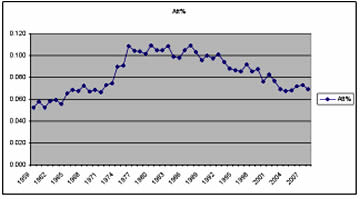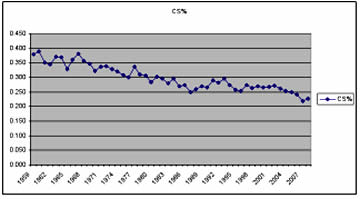BP Comment Quick Links

 | |
June 21, 2009 Prospectus Idol EntryWhen It Doesn't Pay To StealIn 2008, Ichiro Suzuki, regarded as one of the fastest players in baseball, stood at first base with second base empty a total of 262 times. From 2006 to 2008, Ichiro has been thrown out by the catcher on only 9.2% of his attempts, one of the best rates in history. Despite this, he only attempted 34 steals, a rate of 13.0%. In 1980, a year in which Omar Moreno of the Pirates was thrown out by the catcher on 22.2% of his steal attempts, Moreno ran an amazing 68.4% of his opportunities. At that rate, Ichiro could have stolen 163 bases last year. A successful stolen base increases the team's chances of scoring, but it is paired with the risk of the cost in lost opportunity of a caught stealing. The successful steal is most valuable when it is more difficult scoring by other means. In 1968, when Bob Gibson had a 1.12 ERA the average major league wOBA was .289, a successful steal was worth .027 wins, while each caught stealing cost a team .040 wins. With the high offense of recent years, from 1999 to 2002 the value of a steal had dropped to .018 wins, while each caught stealing cost .043 wins. The return is lower, while the cost of being caught is more. In 1968, a runner had to be safe 60% of the time to break even, but now it's risen to 70%. From 1963 to 1968 baseball used a high pitcher's mound and a larger strike zone, depressing offense to the point that in 1968 the majors as a whole hit only 237/302/340. Although these were rescinded in 1969, large ballparks and expansion also helped to keep offensive levels low through 1976. In such an environment, stolen bases were one of those market inefficencies that some teams used to try to gain a competitive advantage. The major league rate of attempting steals of second was 6.7% in 1971, and then began a steady increase until it peaked at 10.9% in 1976. That year, manager Chuck Tanner's Oakland A's stole 341 bases while being caught 123 times. In 1977 Tanner was traded to Pittsburgh, where the Pirates stole 260 bases in Tanner's first year at the helm, and over 200 in three of his first four seasons. The Cardinals and Astros were two teams that played in cavernous stadiums paved with AstroTurf, and both turned their lineups away from power and to speed. From 1976 to 1992, the attempt rate held steady between 9.6 and 10.9%. The premier base thieves were given a green light to steal at will, with Moreno setting the record with a 68.4% rate of attempts in 1980. Rickey Henderson attempted second base 51.5% in his record year of 1982, and again at 50.9% in 1983. Vince Coleman topped 40% six of his first seven seasons, and Tim Raines ran 61.5% of the time in his rookie season of 1981. The brakes were applied starting in 1993, coinciding with an explosion in production in the batter's box that continues to this day. There has been much study of the two year jump in offense in 1993 and 1994, including an article last year by Tom Tango at The Hardball Times, where he advocated a juiced ball as the culprit. Whatever the reason, run scoring was up 13% from 1993 to 2008, compared to 1976 to 1992. Paradoxically, even as the average rate of caught stealing has continued to drop to where it has only been 22% the past two years, the rate of stolen base attempts has also dropped steadily since 1992. With conditions so favorable for power hitting, teams have moved their rosters away from speed and towards power. The higher batter's production has then decreased the benefit of a successful steal while increasing the cost of a caught stealing. With fewer steals being attempted, teams can risk playing offense oriented catchers with below average arms such as Jorge Posada or Ryan Doumit. Therefore, most steals today are attempted when the runner has a substantial advantage - a superior base stealer matched against pitchers and/or catchers lacking the skill to stop him (Dexter Fowler vs Chris Young, Carl Crawford vs Jason Varitek). Being more selective in attempting steals then further drove down the caught stealing rates. In the 17 season from 1976 to 1992, there were 52 player seasons of more than 100 opportunities in which the runner attempted to steal second more than 40% of the time, 9 times higher than 50%. In the 16 seasons since, there have been only 5 player seasons of 40% or better, none higher than 50% - Chuck Carr 42.2% in 1993, Alex Sanchez 41.9% in 2003, Corey Patterson 40.7% in 2006, Jose Reyes 40.2% in 2007 and Roger Cedeno 40.1% in 1999. Today's best base stealers, such as Willy Taveras, Hanley Ramirez, Michael Bourn and Jacoby Ellsbury attempt steals of second base in the 30% range, where as 25 years ago they each would have likely stolen at least half again as often. Ichiro and Carlos Beltran, with two of the lowest rates of caught stealing, only attempt in the 15% range. It was the lack of offense of the early 1970's that drove the push for more stolen bases, but the need for speed was cut back nearly twenty years later when suddenly anyone in the lineup had the ability to hit the ball out of the park. Willy Taveras bragged this past winter that he could steal 100 bases with Cincinnati - of course he will need better than a .270 on base percentage, but he also will likely never be given the green light to attempt 50 or 60% of his opportunities as long as offensive levels stay near their current levels. It just doesn't pay enough.   The play by play information used here was obtained free of charge from and is copyrighted by Retrosheet. Interested parties may contact Retrosheet at "www.retrosheet.org".
|
I get that Brian does the heavy duty stats really well. Well, I get that those people that can understand it think he does it really well. I'm admittedly not the target audience for that. The problem here is that Brian's writing this week is so dry that I don't even want to work to try and get it. This reads like a first draft, an article that he mailed in, like he's done trying to win this contest because he doesn't think he can anymore. I'm disappointed because in addition to Brian's intelligence, he showed a real ability in the article about his experience with the local league that he never exhibited in any of the other weeks. It's there, but I think Brian is better suited to doing his kind of work - following the things that interest him and doing longer studies - rather than trying to be a weekly columnist.